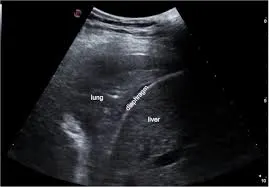How to Interpret Lung Ultrasound: 3 Essential Methods
Lung ultrasound is a powerful imaging technique using sound waves to visualize the lungs and pleural space. This guide will explore what lung ultrasound can reveal, its uses, and how to interpret its findings.
What is a Lung Ultrasound?
A lung ultrasound is a non-invasive, real-time imaging test that uses sound waves to create images of the lungs and surrounding tissues. It is safe, portable, and avoids radiation exposure, making it a versatile tool. Let’s delve into its features and applications.

What Can Lung Ultrasound Show?
- Pleural Assessment: Clear visualization of the pleural line, which helps in identifying pleural effusions or pneumothorax.
- Lung Tissue Evaluation: Identification of consolidation, interstitial patterns, and other abnormalities within the lung tissue.
- Fluid Detection: Accurate identification of fluid accumulation in the pleural space (pleural effusion).
- Real-time Imaging: Allows for dynamic observation of lung and pleural movements, aiding in assessing lung function.
- Guidance for Procedures: Can guide procedures such as thoracentesis (removing fluid from the pleural space).
Why Might You Need a Lung Ultrasound?
- Respiratory Symptoms: Evaluation of causes for shortness of breath, chest pain, or cough.
- Suspected Pneumonia: Diagnosis and monitoring of lung infections.
- Pleural Effusion: Identification and assessment of fluid buildup around the lungs.
- Pneumothorax: Detection of air in the pleural space.
- Monitoring Treatment: Assessing the response to therapy in lung conditions.
How to Interpret Lung Ultrasound Results
Interpreting lung ultrasound results can be challenging. Here’s an overview of three common approaches you can take for analysis:
1. Utilizing X-ray Interpreter
X-ray Interpreter utilizes AI to analyze lung ultrasound images. Here's how to get started:
- Registration: Sign up on X-ray Interpreter to use the AI ultrasound analysis tool.
- Uploading Ultrasounds: Upload your lung ultrasound images.
- Reviewing Interpretation: Receive an AI-generated report including findings, probability score, and relevant notes.
- Consultation: Always follow up with your physician for diagnosis and treatment planning.
Check out our get started guide for more details.
2. Using ChatGPT Plus
ChatGPT Plus offers advanced image analysis, including lung ultrasound assessment:
- Subscription: Subscribe to ChatGPT Plus to access the GPT-4V model.
- Uploading Ultrasounds: Upload your ultrasound images on the OpenAI platform.
- Request Analysis: Ask ChatGPT to interpret your lung ultrasound and generate a report.
- Review and Validate: Review the results and validate the interpretation with a healthcare provider.
Find out more in our blog on using ChatGPT Plus for medical image interpretation.
Alternatively, as several other AI models with vision capabilities emerge, you can also try other models, such as Grok by xAI, Claude by Anthropic, Gemini by Google Deepmind.
3. Understanding the Basics Yourself
While not a substitute for medical expertise, understanding basics enhances comprehension of your results and preparation for doctor visits:
- Learn Anatomy: Study basic lung anatomy, including pleural space and lung tissues.
- Study simple guides: Utilize online guides for understanding ultrasound findings.
- Ask Questions: Note any unfamiliar medical terms and ask for explanation from your provider during your follow-up visit.
- Seek Expert Guidance: Always confirm your understanding with your healthcare provider.
Comparing the Different Approaches
Let's compare different methods for lung ultrasound interpretation:
| Criteria | X-ray Interpreter | ChatGPT Plus | Self-Reading |
|---|---|---|---|
| Accuracy | High (AI-based)1 | High (AI-based)1 | Varies (Skill-dependent) |
| Ease of Use | Easy | Moderate | Challenging |
| Cost | Starting from $2.50 per image | $20 per month | Free (excluding educational costs) |
| Time Efficiency | Fast | Moderate to Fast | Slow to Moderate |
| Learning Curve | Low | Low to Moderate | High |
| Additional Resources | Provided | Partially Provided (through OpenAI) | Self-sourced |
Each method presents its advantages and disadvantages. AI-based options are quick and precise, while self-education promotes better patient-physician interaction.
Conclusion
Lung ultrasounds are valuable in diagnosing various respiratory conditions. This guide has explored its uses, the images it produces, and different ways to analyze results using AI tools and basic knowledge.
When selecting a method, consider your needs, desired understanding level, and resources. Always adhere to privacy standards and consult with a medical professional for proper diagnosis.